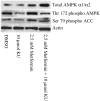Common variants near ATM are associated with glycemic response to metformin in type 2 diabetes
- PMID: 21186350
- PMCID: PMC3030919
- DOI: 10.1038/ng.735
Common variants near ATM are associated with glycemic response to metformin in type 2 diabetes
Abstract
Metformin is the most commonly used pharmacological therapy for type 2 diabetes. We report a genome-wide association study for glycemic response to metformin in 1,024 Scottish individuals with type 2 diabetes with replication in two cohorts including 1,783 Scottish individuals and 1,113 individuals from the UK Prospective Diabetes Study. In a combined meta-analysis, we identified a SNP, rs11212617, associated with treatment success (n = 3,920, P = 2.9 × 10(-9), odds ratio = 1.35, 95% CI 1.22-1.49) at a locus containing ATM, the ataxia telangiectasia mutated gene. In a rat hepatoma cell line, inhibition of ATM with KU-55933 attenuated the phosphorylation and activation of AMP-activated protein kinase in response to metformin. We conclude that ATM, a gene known to be involved in DNA repair and cell cycle control, plays a role in the effect of metformin upstream of AMP-activated protein kinase, and variation in this gene alters glycemic response to metformin.
Figures



Comment in
-
Variation in the ATM gene may alter glycemic response to metformin.Circ Cardiovasc Genet. 2011 Apr;4(2):210-1. doi: 10.1161/CIRCGENETICS.111.960047. Circ Cardiovasc Genet. 2011. PMID: 21505202 No abstract available.
-
Does metformin work for everyone? A genome-wide association study for metformin response.Curr Diab Rep. 2011 Dec;11(6):467-9. doi: 10.1007/s11892-011-0220-0. Curr Diab Rep. 2011. PMID: 21845381 No abstract available.
-
The role of ATM in response to metformin treatment and activation of AMPK.Nat Genet. 2012 Mar 28;44(4):359-60. doi: 10.1038/ng.2236. Nat Genet. 2012. PMID: 22456732 Free PMC article. No abstract available.
-
The role of ATM in response to metformin treatment and activation of AMPK.Nat Genet. 2012 Mar 28;44(4):360-1. doi: 10.1038/ng.2235. Nat Genet. 2012. PMID: 22456733 No abstract available.
-
Highlights from the latest pharmacogenomic genome-wide association studies.Pharmacogenomics. 2013 Mar;14(4):357-60. doi: 10.2217/pgs.13.17. Pharmacogenomics. 2013. PMID: 23438881 No abstract available.
References
-
- Nathan DM, et al. Medical management of hyperglycaemia in type 2 diabetes mellitus: a consensus algorithm for the initiation and adjustment of therapy : A consensus statement from the American Diabetes Association and the European Association for the Study of Diabetes. Diabetologia. 2009;52:17–30. - PubMed
-
- NICE clinical guideline 87 . Type 2 diabetes: the management of type 2 diabetes. National Institute for Health and Clinical Excellence; 2009.
Publication types
MeSH terms
Substances
Grants and funding
LinkOut - more resources
Full Text Sources
Other Literature Sources
Medical
Molecular Biology Databases
Research Materials
Miscellaneous

